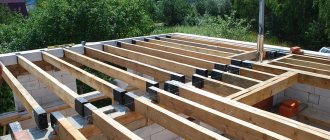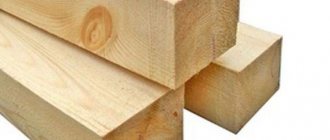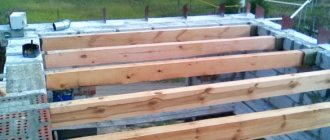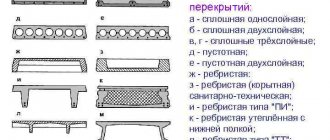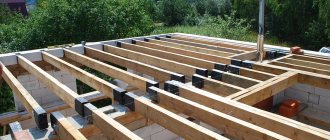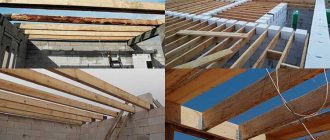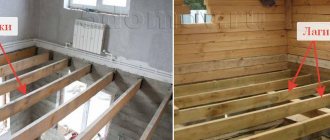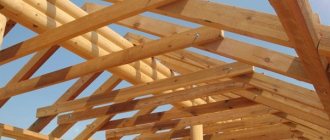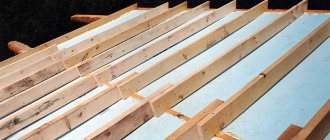An important stage in the construction of any building is the installation of interfloor slabs. They distribute the weight of the building elements above, such as the roof and walls, as well as communications and interior details of the upper floors. To withstand considerable loads, strong floors are needed. In the article we will tell you what types of beams are used for different parts of the building, and consider how to correctly calculate the load and length of beam floors.
Interfloor ceiling with wooden beams
Types of floors
A floor is a horizontal load-bearing structure made of beams that divides a building in height into functional zones or floors and maintains the strength of the entire structure. When building a house, the following types of floors are used:
- basement or basement floor;
- interfloor covering;
- attic floor.
Attic floor
Naturally, the most durable are metal beams in the form of a channel, angle or I-beam, made of high-strength steel. They are best used for the basement floor, as it bears the greatest load. Steel beams can be used to create long spans with large distances between beams. They are resistant to mechanical damage and rotting. However, due to their heavy weight, they are difficult to work with, and the high price of the metal increases construction costs.
Reinforced concrete floor beams can withstand heavy loads and are suitable for the construction of multi-story buildings. But for their installation you will need special equipment.
Basically, in the construction of private houses, wooden beams are used for floors. Wood is a reliable and environmentally friendly material that will not harm the residents of the house. Wooden beams are relatively inexpensive and light in weight compared to previous types, so they are easy to install. However, the tree is flammable, susceptible to rotting and bark beetle damage, and therefore requires pre-treatment.
How to determine the load that will act on the floor
The ceiling transfers the load to the beams, which is summed up from the structure’s own weight (including the weight of the inter-beam insulation and sheathing boards) and the weight of the objects placed on the ceiling. Accurate calculations can only be performed by a special design organization. Simpler calculation methods are available for you to perform independently using the following scheme.
- For attic floors with sheathing boards (not bearing large loads, but insulated with mineral wool), it is true that an average load of 50 kg per 1 m² is applied. In this case, the load on this floor will be equal to: 1.3 × 70 = 90 kg/m² (according to SNiP 2.01.07-85, the number 70 (kg/m²) is the normalized load for this floor; 1.3 is the safety factor) . The total load is 90 + 50 = 130 kg/m².
- If the inter-beam insulation is heavier than mineral wool or a lining of thick boards was used, then the standard load is considered equal to 150 kg/m². Then: 150 × 1.3 + 50 = 245 kg/m² - total load.
- For the attic, the weight of the floor covering, furniture and other interior items is added to the load components. The design load in this case increases to 350 kg/m².
- If the beams are part of the interfloor floor, the design load is assumed to be 400 kg/m².
Types of Wood Beams
Wooden beams vary in size, cross-section, production method and type of wood from which they are made. The reliability and strength of the structure depends on the choice of wooden beams. Depending on the distance between the walls and the expected load for the floors, use a board or beam made of solid wood, or glued products.
Types of wooden beams
Solid beams
Beams made from solid wood are less durable than glued or I-beams. Therefore, their length should not exceed 6 meters. Often, to increase strength, builders on site pair boards. They are tightened with bolts and nuts with rubber or plastic gaskets that prevent moisture from entering and rust forming on the fasteners.
Glued laminated timber
Glued laminated timber is made by gluing several parts together. Beams made of this material can withstand high loads, so they can be used in the construction of floors up to 14 meters long. From such timber you can make bent floors for arches.
Such products also have disadvantages. Low-quality lumber may be used in manufacturing, so the beam floor may shrink over time. In addition, glued beams are much more expensive than solid ones. In order to more efficiently use the funds allocated for construction, you need to correctly calculate the load and length of the beams.
Glued laminated timber with a similar cross-section to conventional timber has greater strength
Floor beams are made from coniferous wood, but oak, acacia, maple and other trees are also often used. The main condition necessary for the strength of the structure is humidity no more than 12–14%. Types of some products are shown in the table below.
I-beams
The advantages of I-beams are versatility of use, ease of installation and high strength. They retain their parameters under heavy loads without auxiliary structures for reinforcement.
I-beam device
I-beams are made using well-dried planed or laminated timber, durable glued waterproof plywood or OSB boards, based on fire-resistant and moisture-resistant glue. Therefore, an I-beam wooden beam does not require impregnation with special compounds and can be easily sawed. However, due to the complex manufacturing technology, they are rarely used for flooring.
I-beams made of OSB (OSB)
Connecting I-beams to each other
All types of products have their own assortment. An assortment is a selection of various finished products by brand, profile or size. Often the table will include additional information about strength, weight, etc.
Calculation of floor beams
Independent calculation of a wooden floor beam is a long and tedious task that requires you to know the basics of engineering disciplines and strength of materials. Without certain skills and knowledge, manually selecting the material, calculating the required section or pitch of the beam is not only difficult, but sometimes impossible. However, we will try to tell you about the main characteristics that are needed for calculations and what algorithm our calculator uses.
Types of beams
Currently, wooden beams used for the manufacture of floors can be divided into two fundamentally different types:
- solid;
- glued
Based on the name, it becomes clear that in the first case, it will be a solid piece of wood of a certain type of section (most often it is a beam with 2 or 4 edges), in the second case, it will be a laminated beam made of boards or LVL veneer.
Despite the low cost, for a number of objective reasons, wooden beams made of solid wood have recently been used less and less . The quality characteristics of this material are significantly inferior to laminated wood: the low modulus of elasticity contributes to the appearance of large deflections in the middle of the span (this becomes especially noticeable when the distance between the load-bearing walls is more than 4 meters), when drying, longitudinal cracks appear on the beams, which lead to a decrease in the moment of inertia of the deflection, Lack of impregnation exposes the wood to pests and rot.
Thanks to modern technologies, glued beams do not have such disadvantages . Their structure is homogeneous and the fibers are oriented in all directions - the overall strength and elastic modulus of the material increases, it receives protection from cracking, and special impregnation provides an increased level of fire safety and moisture resistance. These beams are allowed to be used for openings of 6-9 m and can be considered as a full-fledged analogue of an iron floor.
Solid wood beam
Glued beam from boards
Glued veneer beam
Cut log
Selection of beam section
In order to select the section of a beam yourself manually, you need to have a huge amount of knowledge in the field of strength materials, because you will need to apply in practice a large number of formulas and coefficients, so for a novice master this is a rather difficult and not entirely irrational task. Our calculator should help you make an approximate calculation of a wooden floor and save a significant amount of time. However, the user must understand that no program can replace a real specialist, since the operating principle of the service is based on processing standard tabular values and cannot take into account specific situations.
Calculating wooden floor beams is much easier using our calculator. You don't need to keep a lot of formulas in your head and worry about unproduced errors!
Section of beam floors
The strength of the floor is also affected by the section of the beam. By type of section the following types of lumber are included:
- rectangular;
- square;
- round;
- oval;
- I-beam
The most common are rectangular beam floors. They are easy to install and such beams will serve as lags for arranging floors. When installing rectangular beams, they are installed vertically with the wide part, since the strength of the structure increases with increasing height.
For attic floors, round beams or rounded logs are often used. Such beams have good strength and resistance to deflection.
The strongest and most functional are I-beams.
Calculation of the load and dimensions of wooden beams
Before erecting a building, it is necessary to calculate the load and length of the beam floors. For better floor strength during construction, you need to use wooden beams with a slightly larger safety margin than the calculated one.
Selecting the width or thickness of the beam depending on the length
To correctly calculate the load on a floor beam, you need to:
- Know the distance between walls and the pitch between beams.
- Calculate the constant load consisting of the mass of beams, insulation and materials from which the floor and ceiling are made.
To calculate, you need to add the specific gravity per square meter. meter of all building materials
- Temporary load. This includes the mass of furniture and people in the building. As a rule, it is considered equal to 150 kg/m2.
- Calculate the expected load per 1 m2 of flooring (sum of temporary and permanent indicators).
Since the calculation requires knowing the load per linear meter, you need to multiply the estimated load per 1 m2 by the distance between the beams. Next, the resulting figure is multiplied by the square of the distance between the load-bearing walls and divided by 8. This is how the load of the beam floor is calculated.
Mmax = (q*L2)/8
Where:
- q - full load per sq. m;
- L2 is the square of the distance between the walls.
When designing a floor frame, you need to pay attention to spatial rigidity, which largely depends on the deflection rates of the beam floor.
The calculation of a wooden beam for deflection is carried out according to the formula: W = Mmax / R , where M is the maximum load, and R is the resistance of wood from SP 64.13330.2017 dated 2021 (current edition of SNiP II-25-80). For grade 2 wood it is generally considered to be 130 kg/cm2.
From the formula W = b*h2/6, knowing the indicator W, we calculate the cross section of the floor. It is enough to specify one geometric characteristic b (section width) or h (its height).
The deflection of the wooden floor under the calculated load should not be greater than the ratio to the length of the beam of 1:350 for basement and interfloor floors, and for attics and mansards - 1:250.
The size of the beams depends on the distance between the load-bearing walls. To determine the required beam length, add 40 cm to this value, approximately 15–20 cm on each side. Professional builders recommend using beams with a cross-section equal to 4–5% of the span length to construct the floor.
Wooden floors
Among the many structural elements of a private house, the ceiling is one of the most important and difficult to design and install components. This is where inexperienced builders make, perhaps, the most dangerous mistakes; it is about the arrangement of this system that the most questions are asked.
Wooden floor beams - timber 100x200 mm
Why choose a tree
In any building, the ceiling is a horizontal structure that serves as the basis for creating the floor. In addition, being connected to the load-bearing walls of the house, it provides lateral stability to the structure, evenly distributing possible loads. Therefore, the highest demands are placed on the reliability of this design.
Regardless of what material is used in the construction of a house, wooden floors are most widespread in the private sector. They can often be seen in various stone cottages, and it is quite obvious that in wooden construction (logs, beams, frame and frame-panel technology) there is no alternative to such a solution. There are many objective reasons for this. Let's look at the advantages and disadvantages of wood floors.
In private low-rise construction, floors are installed in several options:
- Ready reinforced concrete slab,
- Monolithic reinforced concrete slab,
- Ready-made reinforced concrete beams,
- Beams and trusses made of rolled metal,
- Flooring made of lumber.
Timber floor joists
Floor joists made of boards on wood grouse
Beam made of timber on mounting plates
pros
Or why wooden floors are so popular.
- Small mass. By using boards or timber, we do not overload load-bearing walls and foundations. The weight of the ceiling is several times less than that of concrete or metal structures. Usually no technology is required.
- Minimum deadlines for completing work. Minimum labor intensity among all options.
- Versatility. Suitable for any building, in any environment.
- Possibility of installation at sub-zero and very high temperatures.
- No “wet” or dirty processes.
- Possibility of obtaining any level of thermal insulation and sound insulation characteristics.
- Possibility of using cavities for laying utilities (electrical network, heating, water supply, sewerage, low current...).
- The relatively low price of a prefabricated frame floor made of lumber, both in terms of the cost of parts/components and the contractor’s wages.
Laying communications in cavities
Minuses
The disadvantages of a wooden ceiling system made of wood are quite conventional.
- The difficulty of choosing the cross-section of materials and design solutions to ensure the calculated load-bearing capacity.
- The need to carry out additional fire prevention measures, as well as provide protection from moisture and pests (antiseptic treatment).
- The need to purchase soundproofing materials.
- Strict adherence to technology to avoid construction errors.
What material to use for assembly
Wooden flooring always consists of beams. But they can be made from a variety of lumber:
- Rounded log up to 30 cm in diameter.
- The beam is four-edged.
- Large section board (thickness from 50 mm, width up to 300 mm).
- Several boards of relatively small thickness, twisted face to face.
- I-beams, the upper and lower chords of which are made of edged planed boards/bars, and the vertical wall is made of OSB-3, plywood or profiled metal (wood-metal product).
- Closed boxes made of sheet materials (plywood, OSB).
- SIP panel. In essence, these are separate sections in which the beams are already sheathed and have an insulator inside.
- Various truss designs, allowing to cover large spans.
The easiest options for installation, as well as the cheapest and most convenient for subsequent operations, are those where the floor beams are made of edged lumber.
Due to the very high requirements for load-bearing capacity, durability and geometric deviations, first-grade lumber must be considered as blanks. It is possible to use products classified as second grade according to GOST, which do not have critical geometric deviations, defects and processing defects that can reduce the strength characteristics and service life of finished parts (through knots, twists, cross-layers, deep extended cracks...).
In these structures, the use of dead wood (dead wood, dead wood, burnt wood) is excluded due to insufficient strength and multiple damage to wood-destroying diseases and insects. It would also be a big mistake to buy a timber or board “with air”, “with Armenian size”, “TU” - due to the underestimated sections.
This should be exclusively healthy material from green spruce or pine, since needles, due to their resin content and solid structure, can withstand bending loads and compression much better than most hardwoods, and having a relatively low specific gravity.
In any case, edged lumber must be freed from remnants of bark and bast fibers, treated with an antiseptic and fire retardant. Dry planed lumber will perform best here, but material with natural humidity (up to 20 percent) during normal processing is also actively (and most importantly, effectively) used, especially since the price of edged timber or boards of this type is noticeably lower.
Edged board flooring
Beams are glued together from OSB using SIP technology
Edged timber ceiling
How to choose the size of beams and at what step to arrange them
The length of the beam is calculated in such a way that it covers the existing span and has a “margin” to provide support on load-bearing walls (read below for specific figures for permissible spans and wall penetration).
To set the calculated thickness and length of the beam, you can use splicing technology
No matter how the beam is constructed, waterproofing is necessary
The cross-section of the board/beam is determined depending on the design loads that will be exerted on the floor during the operation of the building. These loads are divided into:
- Permanent.
- Temporary.
Temporary loads in a residential building include the weight of people and animals that can move along the floor, moving objects. Constant loads include the mass of the lumber of the structure itself (beams, joists), floor filling (insulation/noise insulation, insulating sheets), hemming (rolling), rough and finishing flooring, finishing flooring, partitions, as well as built-in communications, furniture, equipment and household items...
Also, you should not lose sight of the possibility of storing objects and materials, for example, when determining the load-bearing capacity of the floors of a non-residential cold attic, where unnecessary, rarely used things can be stored.
The sum of the permanent and live loads is taken as a starting point, and a safety factor of 1.3 is usually applied to it. Exact figures (including the cross-section of lumber) must be determined by specialists in accordance with the provisions of SNiP 2.01.07-85 “Loads and Impacts”, but practice shows that the load values in private houses with wooden beams are approximately identical:
- For interfloor (including under a residential attic) and basement floors, the total load is about 350 - 400 kg/m2, where the share of the structure’s own weight is about 100 kilograms.
- For covering an unloaded attic - about 130 - 150 kg/m2.
- For covering a loaded non-residential attic up to 250 kg/m2.
It is obvious that unconditional safety is of paramount importance. Here a good margin is taken into account and the option is considered not so much of distributed loads on the entire floor (in such quantities they are practically unrealistic), but rather the possibility of a local load that can lead to deflections, which in turn caused:
- physiological discomfort of residents,
- destruction of components and materials,
- loss of aesthetic properties of the structure.
By the way, certain deflection values are allowed by regulatory documents. For residential premises, they can be no more than 1/350 of the span length (that is, 10 mm at 3 meters or 20 mm at six meters), but provided that the above limiting requirements are not violated.
When choosing the cross-section of lumber to create a beam, they are usually guided by the ratio of the width and thickness of the beam or board in the range of 1/1.5 - 1/4. Specific figures will depend, first of all, on: loads and span lengths. When designing yourself, you can use data obtained from calculations using online calculators or publicly available tables.
Optimal average cross-section of wooden floor beams, mm
| Load, kg/m2 | Span 3 m | Span 3.5 m | Span 4 m | Span 4.5 m | Span 5 m | Span 5.5 m | Span 6 m |
| 150 | 50Х150 | 50Х150 | 50Х200 | 150Х150 | 100Х200 | 100Х200 | 100Х220 |
| 200 | 50Х150 | 50Х200 | 70Х180 | 80Х200 | 100Х200 | 120Х220 | 140Х220 |
| 250 | 60Х150 | 60Х180 | 70Х200 | 100Х200 | 150Х200 | 150Х220 | 160x220 |
| 350 | 100Х150 | 70Х180 | 100Х200 | 150Х200 | 150Х220 | 160Х220 | 200Х220 |
As you can see, in order to increase the load-bearing capacity of the floor, it is enough to choose lumber with a larger width or greater thickness. It is also possible to assemble a beam from two boards, but in such a way that the resulting product has a cross-section no less than the calculated one. It should also be noted that the load-bearing properties and stability of a wooden floor increase if logs or various types of subfloors (sheet flooring made of plywood/OSB or edged boards) are used on top of the beams.
Another way to improve the strength properties of a wooden floor is to reduce the spacing of the beams. In their designs for private houses, engineers determine under different conditions the distance between beams from 300 mm to one and a half meters. In frame construction, the pitch of the beams is made dependent on the spacing of the posts, so that there is a post under the beam, and not just a horizontal frame run. Practice shows that the most appropriate from the point of view of practicality and cost of construction is a step of 600 or 1000 mm, since it is best suited for the subsequent installation of insulation and noise insulation by surprise (insulating materials have just such a form factor of plates and rolls). This distance also creates the optimal distance between the support points for installing floor joists installed perpendicular to the beams. The dependence of the cross section on the pitch is clearly visible from the numbers in the table.
Possible cross-section of floor beams when changing the pitch (total load per square meter is about 400 kg)
| Pitch, mm | Span 3 m | Span 4 m | Span 5 m | Span 6 m |
| 600 | 100Х200 | 100Х200 | 150Х200 | 200Х200 |
| 1000 | 100Х225 | 150Х200 | 150Х225 | 200Х225 |
How to properly install and secure beams
We have decided on the step - from 60 centimeters to a meter will be the golden mean. As for spans, it is best to limit yourself to 6 meters, ideally: four to five meters. Therefore, the designer always tries to “lay” the beams along the smaller side of the house/room. If the spans are too large (more than 6 meters), then they resort to installing load-bearing walls or support columns with crossbars inside the house. This approach makes it possible to use lumber of a smaller cross-section and increase the spacing, thereby reducing the weight of the floor and its cost for the customer with the same (or better) load-bearing characteristics. As an option, trusses are created from lighter lumber using metal perforated fasteners, for example, nail plates.
In any case, the beams are placed strictly horizontally, parallel to each other, maintaining the same pitch. The wooden beam must rest on load-bearing walls and purlins by at least 10 centimeters. As a rule, 2/3 of the thickness of the outer wall is used on the room side (so that the end of the beam does not go outside and remains protected from freezing). In wooden walls, cuts are made, in stone walls, openings are left during laying. In places where the beams of supporting structures touch, it is necessary to lay insulating materials: damping elastic pads made of rubber/felt, several layers of roofing felt as waterproofing, etc. Sometimes they use firing of sections of the beam that are subsequently hidden or coating them with bitumen mastics/primers.
Beam support
Nail plate
Damper tape
Recently, special perforated brackets “beam holders/supports” have been increasingly used to create floors, which allow the beam to be mounted end-to-end with the wall. Using this type of brackets, units with transverse crossbars and beams truncated in length are also assembled (opening for a flight of stairs, chimney passage, etc.). The advantages of this solution are obvious:
- The resulting T-shaped connection is very reliable.
- The work is done quickly (there is no need to make cuts, it is much easier to set a single plane).
- No cold bridges are formed along the body of the beams, because the end is moving away from the street.
- It is possible to buy lumber of shorter length, since there is no need to insert the timber/board inside the wall.
In any case, it is very important, after adjusting the lumber to size, to thoroughly antisepticize the end of the beam.
What insulating layers should be used inside wooden floors?
To answer this question, first of all, it is necessary to divide the overlapping structures (in a year-round habitable house) into three separate types:
- Basement ceiling,
- Interfloor,
- Attic.
In each specific case, the set of pie will be different.
Interfloor ceilings in the vast majority of cases separate rooms in which the temperature regime is similar or close in value (if there is room/floor/zone adjustment of the heating system). These also include the attic floor, which separates the residential attic, since this room is heated, and the insulation is located inside the roofing pie. For these reasons, thermal insulation is not needed here, but the issue of combating noise, airborne (voices, music...) and shock (steps, rearranging furniture...) becomes very relevant. As sound insulation, acoustic fibrous materials based on mineral wool are laid in the ceiling cavity, and sheets of sound-proofing membranes are also laid under the sheathing.
Design for dry rooms
Design for wet rooms
The basement design assumes that under the ceiling there is soil or a basement, cellar, or ground floor. Even if the room below is equipped for use, this type of floor requires full insulation, characteristic of the enclosing structures of a specific climate zone and a specific building with its unique thermal balance. According to the standards, on average for the Moscow region the thickness of a modern insulation with good thermal conductivity will be about 150-200 mm.
Similar thermal insulation requirements apply to the attic floor, which does not have a heated attic above it, because it will be the main barrier to heat loss through the roof of the building. By the way, due to the greater flow of heat through the upper part of the house, the thickness of the insulation here may be required more than in other places, for example, 200 mm instead of 150 or 250 mm instead of 200.
They use polystyrene foam, EPS, mineral wool with a density of 35 kg/m3 in slabs or cut into mats from a roll (the one that is allowed for use in non-load-bearing horizontal structures is suitable). Thermal insulation is laid between the beams, usually in several layers, with the joints bandaged. The load from the insulation is transferred to the beam through the rough hemming (often it is attached to the beams using cranial bars).
Where wadding insulation/sound insulation is used in structures, it should be protected from moisture. In the basement, moisture can rise in the form of evaporation from the ground or from the basement/cellar. Water vapor can enter interfloor ceilings and attics, which always saturates the air in residential premises during human activities. In both cases, underneath the insulation you need to lay a construction vapor barrier film, which can be ordinary or reinforced polyethylene. But, if thermal insulation is performed using extruded polystyrene foam, which does not have any significant level of water absorption, then a vapor barrier will not be needed.
On top, insulation and fibrous soundproofing materials are protected with waterproof sheets, which can be membranes or non-perforated waterproofing.
A reliable hydrobarrier is especially relevant in rooms with high humidity: kitchen, laundry, bathroom... In such places it is spread on top of the beams, always with the strips overlapping by 100-150 mm and gluing the seam. The canvases along the entire perimeter of the premises must be placed on the wall - to a height of at least 50 mm above the finishing coating.
It makes sense to supplement the ceiling, which will later be tiled with tiles, with a rough flooring made of waterproof sheet materials - various types of cement-containing slabs, preferably tongue-and-groove. On such a continuous flooring, you can carry out additional coating waterproofing, perform thin-layer leveling of the plane with leveling compound, or lay tiles immediately.
You can choose another option - assemble a continuous flooring from edged boards, lay a hydraulic barrier, pour a thin-layer screed (up to 30 mm), and install tiles.
There are also modern adhesive compositions (and elastic grouts) that allow tiling of wooden bases, including movable and heated ones. Therefore, tiled floors are often sold here on moisture-resistant plywood or OSB.
Important! Taking into account the increasing loads (general or local - a large bathtub, a Jacuzzi bowl, a floor-standing boiler...), the calculation of the cross-section and pitch of beams under such rooms must be performed individually.
If desired, the floors in the bathroom or kitchen of a wooden house can be equipped with a heating cable or pipes of the water circuit of the heating system. They are mounted both in screeds and a layer of tile adhesive, and between joists in a deliberately created air gap. With any chosen option, the ceiling must be well insulated so as not to heat the ceiling of the room from below, preferably equipped with waterproofing with a reflective foil layer.
Floor installation
In order for a building to last for a long time, beam floors must meet a high level of strength. Have good sound and heat insulation, as well as good ventilation.
When installing wooden beams, the lighthouse installation method is most often used. First, the outer beams are installed, and then the intermediate ones. To avoid mistakes during work, use a level. In case of height differences, the beams can be leveled by placing cuttings soaked in bitumen primer under the end ends.
Before installation, the beams are spliced or cut to the required size. Splicing of timber beams along their length is usually carried out using the “key groove” method. To do this, the ends of the beams are cut down to 1/2 thickness and one end is buried into the thickness of the other. Then the joints are fixed.
Splicing two beams
The distance between wooden beams should not be less than 60 cm and exceed 1 meter. In a structure made of logs or laminated veneer lumber, the step is taken longer than in plank floors. When installing an attic floor, the distance between the chimney and the beams must be at least 40 centimeters.
To ensure the strength of the frame, the ends of the beams are recessed into the load-bearing wall by at least 15 cm. For I-beams, this value can be reduced to 7 cm. The recesses are sealed with mortar or foam. It is possible to secure the ends to the walls using steel ties. Waterproofing is done in the support areas on the beams.
Waterproofing of beams at support points is required
Advantages and disadvantages of wooden beams
The use of wooden beams in the construction of buildings, unlike other types, is characterized by the following advantages:
- affordable price;
- ease of delivery to the construction site;
- possibility of installation without the use of special equipment;
- environmental Safety;
- maintainability.
However, despite many advantages, such floors are less durable than metal and reinforced concrete. They require treatment with fire retardants, as well as agents against rot and mold. Installation of wooden beams is possible only after careful calculations.
In conclusion of the article, it should be added that the use of wood in construction significantly reduces costs. In order not to disturb the structure of the entire building and install durable floors, it is better to entrust their design and installation to professional builders.
